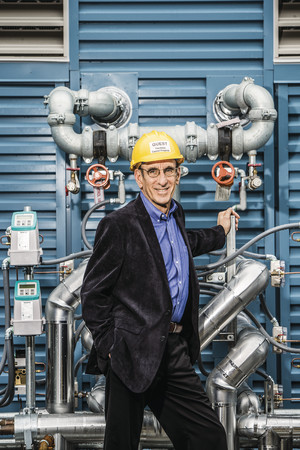 |
| Stephen Selkowitz, photographed by Eric Millette on February 11, 2014, at LBNL's FLEXLab in Berkeley, California. |
Stephen Selkowitz is leader of the windows and envelope-materials group and senior advisor for building science at Lawrence Berkeley National Laboratory (LBNL) in Berkeley, California. From 1985 to 2011, he headed LBNL’s building-technologies department, where he was the driving force behind a just-completed plug-and-play testing complex, the Facility for Low Energy Experiments (FLEXLab). Here users can mock up and evaluate the performance of proposed designs with actual building components such as cladding, windows, lighting, and mechanical systems. The new FLEXLab includes a rotating test bed that allows project teams and manufacturers—among others—to assess building environments in different orientations. On April 3, Selkowitz received the 2014 Award of Excellence from RECORD's sister publication Engineering News-Record for his role in the development of the FLEXLab. Click on the video above to watch his acceptance speech.
What are the problems endemic to the design and construction industries that FLEXLab works to address?
The high-level problem is the integration challenge. In the last 10 to 20 years, the building community has gotten pretty good at making individual energy-saving components such as low-E gas-filled triple glazing or light fixtures with lower lighting power densities. But we haven’t done such a good job at putting them all together into an integrated package. This is a particular issue when there are “moving parts” such as electro-chromic glass, motorized shades, dimmable lights, or occupancy sensors. The problem is compounded when the goal is to deliver energy efficiency, along with load management under peak conditions and occupant comfort. Project teams and owners want to meet these goals on day one, but they also want to do it over time, month after month, year after year. That’s where we see failures: some of it is poor design, some of it is improper specifications, some of it is installation, some of it is calibration, some of it is operations. FLEXLab was designed to address all aspects of the problem.
Who will be the first official user of FLEXLab?
We recently signed a contract with Webcor. It is the contractor for a new building for a biotech firm in the Bay Area. It has a bunch of innovative systems: fixed external shading, internal operable shading, daylight dimming, and lighting controls. They all need to work as an integrated system. We will set up the design as it currently exists in our rotating facility and turn it to the exact orientation of the building on the site. Then we will conduct a series of tests over about three months. Since the building is already under construction, the primary elements—the steel, the glass, etc.— have been ordered. But there are many details—the fabric for the automatic shading, the control levels that will trigger the shading, and the sensor locations, for example—that have yet to be determined. The hope is that the FLEXLab will allow them to iron out all the wrinkles so that the building works right out of the box once it’s occupied.
Is FLEXLab the first testing facility of its kind?
For the last two years we’ve been collaborating with folks in Norway, where they’re doing a lot of R&D on zero-energy buildings. They have some test-bed facilities, and they’re writing proposals to do a larger one that would be somewhat like FLEXLab. We’ve shared information with them. I found a group in Germany that built two side-by-side test facilities at a smaller scale that also rotate. We have a researcher from Germany coming here this summer to share information. But what’s really interesting is that the government of Singapore has just given us a contract to build a FLEXLab-like facility with a rotating side-by-side set of test rooms.
We are advising them not only on the construction, but also on the business plan, on how to engage industry, and on what kinds of testing to do. We hope that a couple of years down the road we might be able to do testing at the equator, in super-hot, humid conditions and then test the same strategies here in Berkeley. Our vision all along—and we’ve stated this even in our original proposal—was that there needs to be more than one FLEXLab. In the long run buildings are important enough and energy is important enough that there should be multiple facilities like this in the country and around the world.


Post a comment to this article
Report Abusive Comment